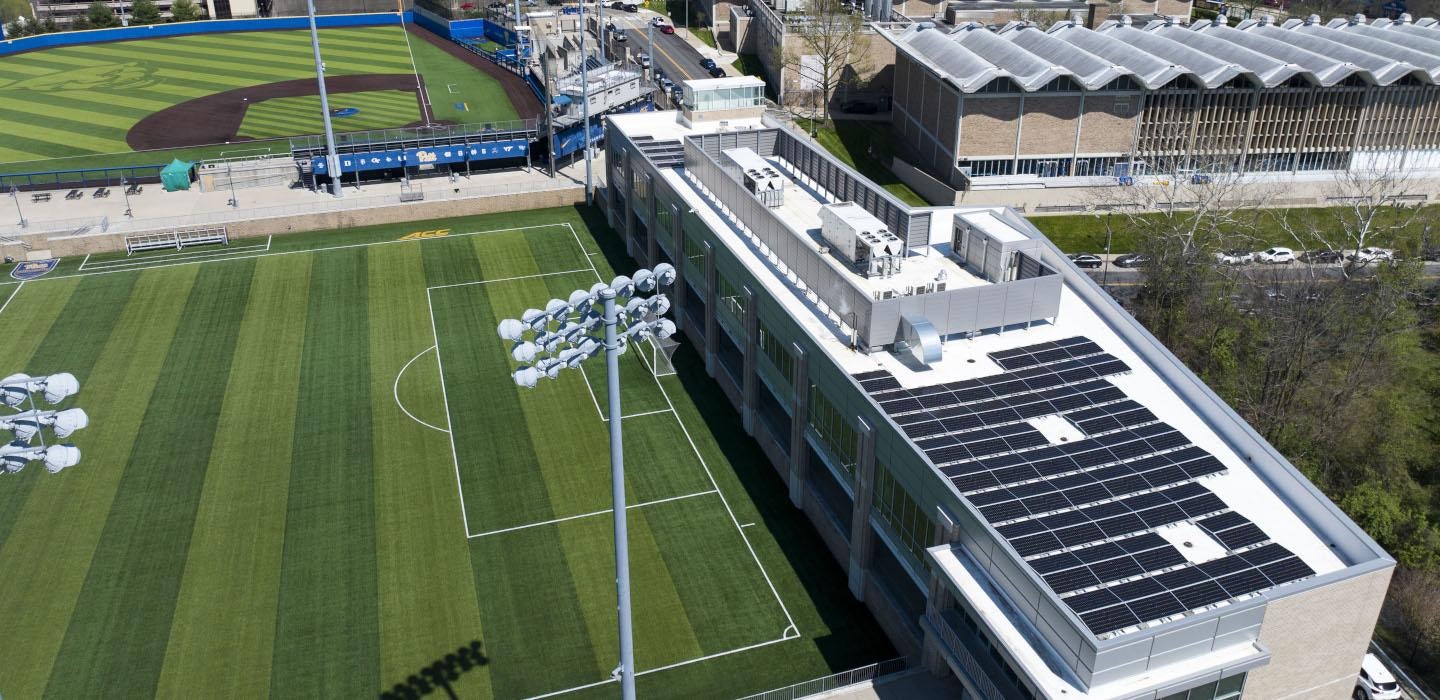
Subscribe to Pittwire Today
Get the most interesting and important stories from the University of Pittsburgh.There’s plenty of new construction underway across Oakland. And some exciting projects may have gone over your head — literally.
Multiple rooftop solar power arrays are being installed across the Pittsburgh campus in support of the Pitt Climate Action Plan. These installations contribute to Pitt’s goals of producing or procuring 50% renewable electricity by 2030 and reaching carbon neutrality by 2037.
Already in 2024, solar panels were installed atop the Petersen Sports Complex, and more are being added to Ruskin Hall, Posvar Hall and David Lawrence Hall. The combined 1.08 megawatts of arrays will produce around 1,128,680 kilowatt hours (kWh) of electricity a year — the equivalent of powering 61.5 homes or removing 109 cars from the road.
Among the installations, Posvar Hall’s rooftop solar array will become the University’s largest, at 650 kilowatts (kW); David Lawrence Hall’s solar will total 170 kW, the Petersen Sports Complex is 68 kW and Ruskin Hall will be 143 kw, along with being Pitt’s first residence hall to sport solar. This expansion bolsters rooftop solar use on the Pittsburgh campus, which previously had limited arrays atop Benedum Hall.
Additionally, many buildings in design or under construction will include solar on their roofs, including the Campus Recreation and Wellness Center, Fifth and Halket building, Arena and Sports Performance Center and Pitt BioForge.
Pitt’s new solar arrays will supply electricity directly to each building they reside on, decreasing the electricity the University needs to purchase. Once the solar panels are up and running, Pitt Sustainability dashboards will be available online to show how much each array is producing.
To determine locations, the Facilities Management team assessed campus building roofs to determine the potential for rooftop solar use at each location. When the University re-roofs existing buildings to maintain them, the opportunity for installing solar panels is also considered.
Pittsburgh-based installer EIS Solar is providing the new solar arrays, using bifacial solar modules — which produce power from both the front and back — and power optimizers to harvest the sun in the most efficient manner. In addition, the arrays use U.S.-made racking systems and electrical components. Minority-owned firm Imbutec is installing the systems in partnership with Pitt.
Rooftop solar power is a visible, high impact solution to reduce carbon emissions, and is just one avenue by which Pitt is pursuing solar energy. The largest contributor to Pitt’s renewable energy journey is the University’s partnership with the 20 megawatt Gaucho Solar Farm near Pittsburgh International Airport, which came online in June 2023. The University also committed to purchasing local, renewable power from the future hydroelectric plant along the Allegheny River.
Pitt-Bradford has led the way in the University’s rooftop solar use, which was recognized this week by Pennsylvania Gov. Josh Shapiro’s administration with a Governor’s Award for Environmental Excellence. The George P. Duke Engineering and Information Technologies Building array started producing solar electricity in March 2023 and has produced 120,000 kilowatt hours since then — the equivalent of powering 6.3 homes for a year. Students in Pitt-Bradford’s Energy Science and Technology program led the development of a new dashboard for this array last year, documenting real-time electricity production and carbon emissions avoided.
In recognition of Pitt’s sustainability achievements, AASHE honored the University with a STARS Gold rating for the second time in 2024. Pitt also received a PA Solar Center Lodestar Award for its solar energy leadership.
The Pitt Climate Action Plan details key strategies to reduce campus-wide energy use, help the Pitt community make more active, shared and low carbon connections; and reinforce behaviors to reduce carbon emissions, working together to make a difference for people and the planet.
Learn more about Pitt’s use of renewable energy, including solar.
— Melanie Lippert, photography by Tom Altany


